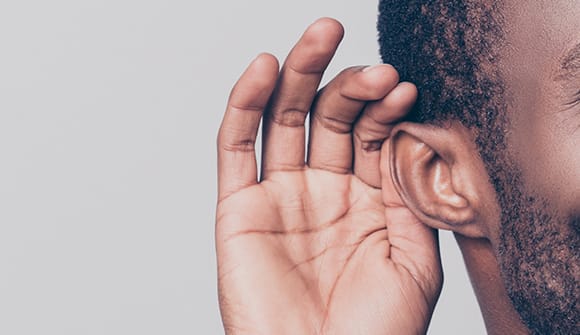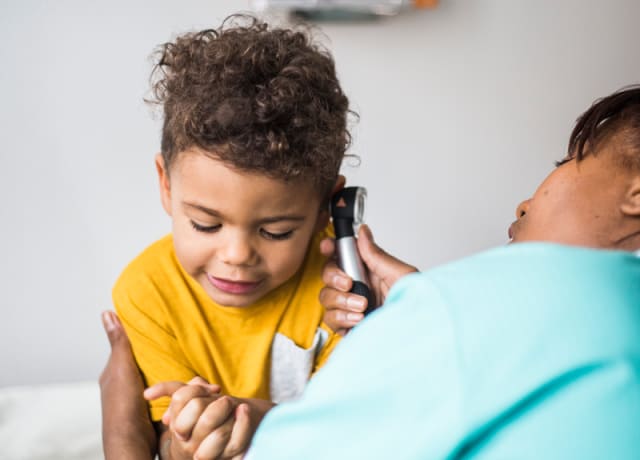Say that again
If you suffer from untreated hearing loss, you could be missing a whole lot more than words.
Article Date:

Do you often find yourself turning up the volume to the television or asking friends or family to repeat what they said? Or, do you often misinterpret things people say?
If so, you may be one of about 15% or more than 37 million adults age 18 and over who have trouble hearing. That percentage increases to about 50% for people 75 and older.
But hearing loss impacts adults and children of all ages. In fact, statistics show that one in eight people in the U.S. who are 12 years or older have hearing loss in both ears. The Centers for Disease Control and Prevention says that less than half of adults who reported hearing problems saw a health care provider about their hearing in the past five years.
And while about 28.8 million adults could benefit from using hearing aids, only 16% have ever used them, according to the National Institute on Deafness and other Communication Disorders.
Angela Johnson, Aud, an audiologist, said the onset of hearing loss is typically gradual so people are often unaware of the extent of its effects, including personality changes, confusion and aloofness.
Signs of hearing loss
In addition to making volume adjustments on electronics and phones, and asking people to repeat what they say, some other signs of hearing loss include:
- Struggling to hear
- Hearing but not understanding what people say
- Misinterpreting words
- Hearing mumbling sounds when people speak
"People often say, `I know someone is talking to me, but I can't clarify what the words actually are.' They hear the voice, but can't make out what the person is saying to them," Dr. Johnson said.
People with hearing loss generally wait years before seeking help. But delays can also cause stress, anxiety, depression, low morale, isolation, risk of cognitive decline and even health problems.
"Hearing aids can make listening a lot easier and a lot less effortful so you are not frustrated or tired at the end of the day because you are working so hard trying to hear," Johnson said.
Not realizing what you're missing
Sometimes people don't realize they have a hearing loss because their brain has adapted to the decrease in hearing.
"Each year you age, your brain gets used to the changes and thinks this is what normal sounds like. It's hard to realize what you are missing if you don't know," Dr. Johnson said. "People think they are getting by and then when they hear through a hearing aid, they realize, `I should have been hearing this all the time.' Once they hear how clear and crisp things are supposed to sound, most don't want to go without their hearing aids again."
There's also been a stigma when it comes to hearing aids. But hearing aids today are not like your grandfather's from 20 or more years ago.
"Hearing aids have changed drastically in recent years," Dr. Johnson said. "New features have revolutionized how smart and discreet these devices can be. There's a stigma that hearing aids make people look old, yet age doesn't necessarily determine when hearing loss may begin. It can happen at any age."
Dr. Johnson said family members and friends generally notice first that an individual they care about is having hearing problems and asking them to repeat what they said or that their loved one is not joining in on the conversation.
"If the same person wore a hearing aid and was able to communicate seamlessly, no one would likely even notice a hearing aid was the reason," Johnson added. "Patients who have accepted their hearing loss and are emotionally ready for help are likely to be more successful in their hearing aid journey."
Various brands use smart technology so you can make volume adjustments for different settings (i.e. a noisy restaurant) from your cell phone via Bluetooth. People can also stream T.V. shows and listen to podcasts through their hearing aid. Instead of charging a battery once a week, hearing aids can be put on a charger overnight like charging a cellphone. They are also easily concealed with various colors to match people's hair color and skin tone.
Hearing aids work, Dr. Johnson said, by receiving sound through a microphone, either on top or in the ear. The sounds are then digitally converted and sent through an amplifier. The amplifier makes the signal louder and sends it to the ear through a speaker.
"We talk to patients about their lifestyle and listening needs to help determine which hearing aid will work best for them," Dr. Johnson said.
Steps to take if you have hearing loss
When to get a hearing test depends on the individual and whether they are experiencing problems. But Johnson said it's important to get a baseline hearing test between the ages of 55 and 60 so you can be monitored for any changes.
"Your hearing should be checked regularly, just like eye exams," Johnson said. "Your ears are just as important as your eyes or any other part of your body. The longer you wait to address your hearing loss, the longer your brain goes without good input. Early intervention is key in how successful you may be in the long run with hearing aids, so the sooner you address the issue, the better."
Adjustment times vary between patients. A 30-day trial period is included with all hearing aid purchases and during that time follow-up appointments are utilized to help patients adjust at their own pace. During that month, patients are typically seen two to four times for adjustments, Johnson said.
While hearing aids are not typically covered by insurance, there is a wide range of pricing depending on technology levels.
If you’re experiencing hearing loss, call 904.202.4YOU (4968) or fill out the appointment request form for help finding an audiologist or ear, nose and throat specialist near you.



